- June 29, 2023
Great Pyrenees vs Newfoundland: Differences Explained (With Pictures)
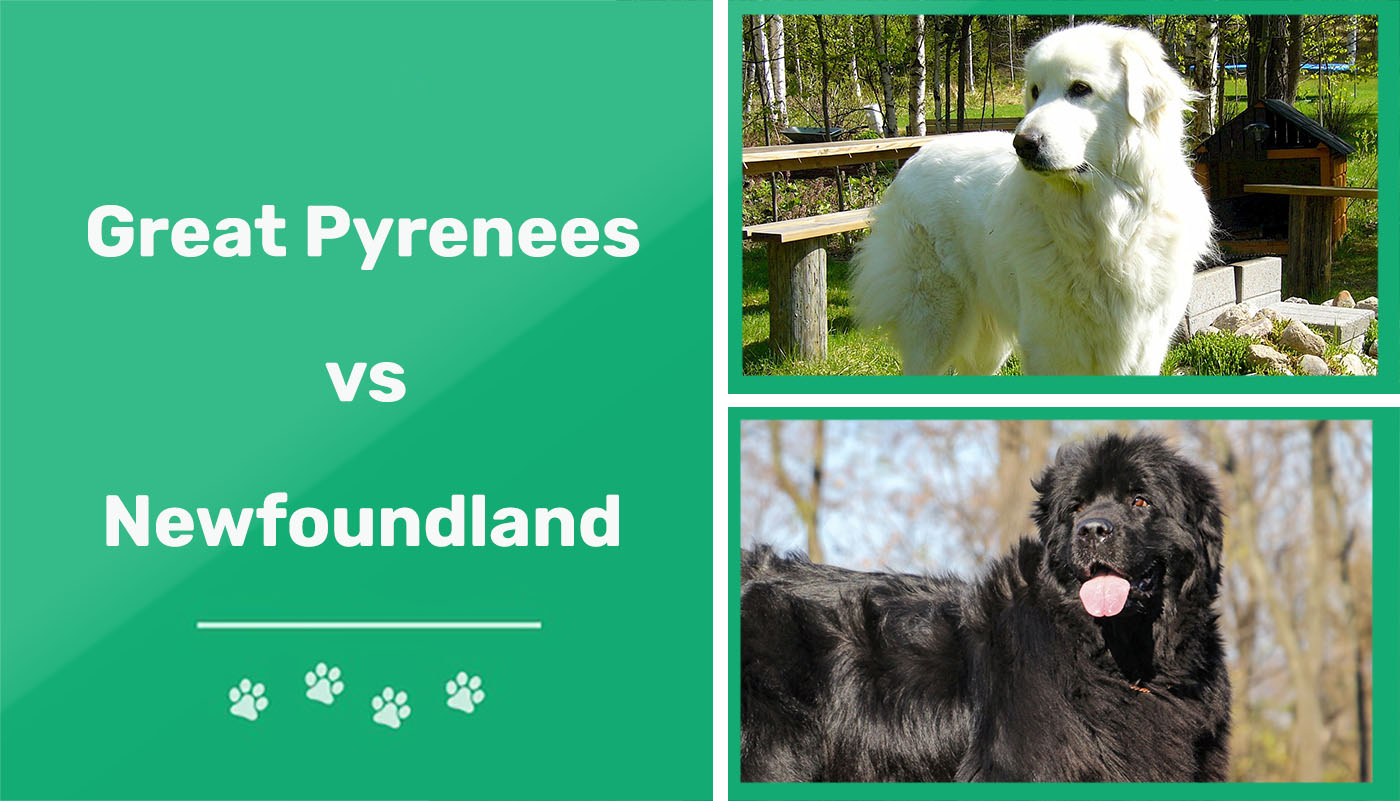
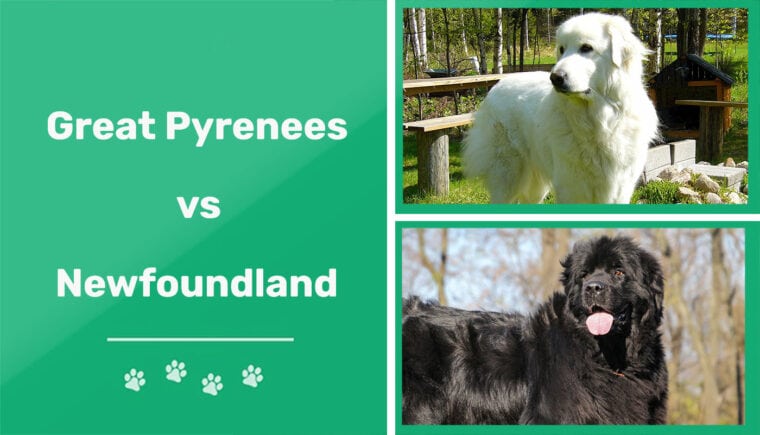
The Great Pyrenees and the Newfoundland have hearts bigger than their physique and are popular companions for owners looking for large, gentle dogs. If you have trouble choosing between these two magnificent breeds, we understand your predicament and are here to help!
While there are many similarities between these two breeds, they also differ in key areas that will help you determine which is the right fit for you and your family. In this article, we’ll discuss the care needs and differences of both breeds.

Visual Differences
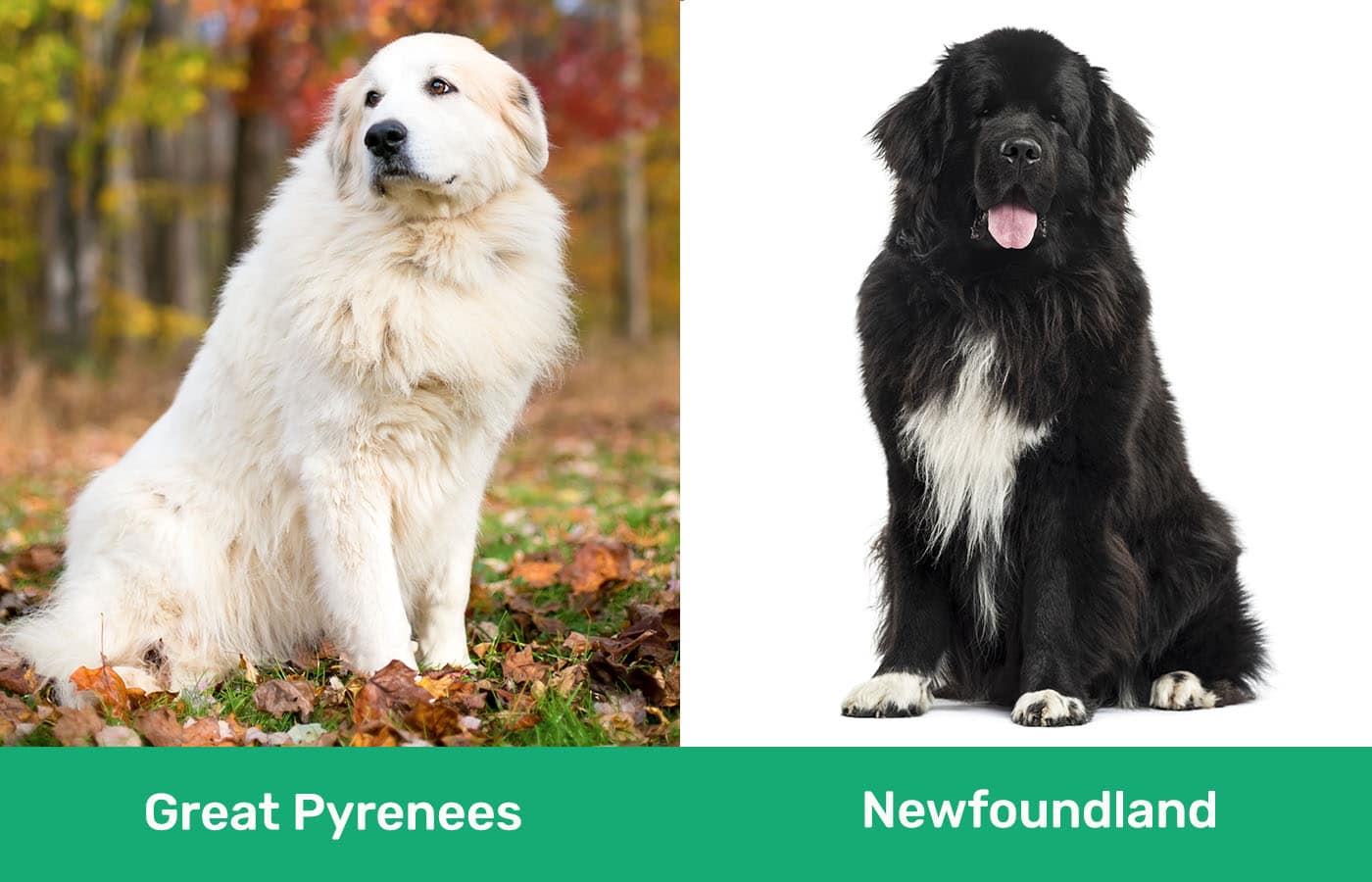
At a Glance
Great Pyrenees
- Average height (adult): 25–32 inches
- Average weight (adult): 85–160 pounds
- Lifespan: 10–12 years
- Exercise: hours a day
- Grooming needs: Moderate
- Family-friendly: Yes
- Other pet-friendly: Often
- Trainability: Intelligent, independent
Newfoundland
- Average height (adult): 25–29 inches
- Average weight (adult): 120–180 pounds
- Lifespan: 8–10 years
- Exercise: 30–45 minutes a day
- Grooming needs: Moderate
- Family-friendly: Yes
- Other pet-friendly: Often
- Trainability: Easy-going, intelligent

Great Pyrenees Overview
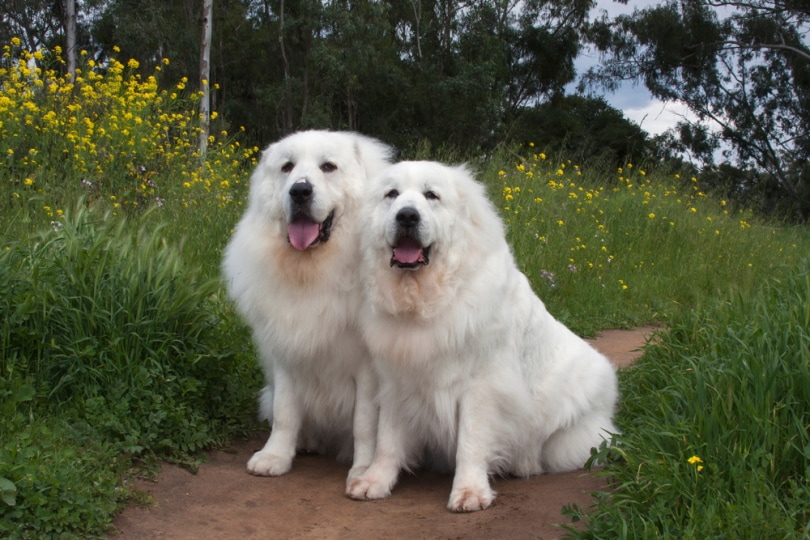
The Great Pyrenees is a large, majestic breed, loved for its thick, white coat and laid-back nature. They were initially bred to guard and protect livestock from predators on the tops of snow-capped mountains, and today they are devoted family guardians and easy-going companions.
Personality
Originally bred to guard sheep, the Great Pyrenees had to learn to conserve its energy until it was time to fight and protect. This trait makes them loyal protectors of their humans, but they’re somewhat wary and hostile toward strangers. They also have an independent streak, which can make obedience training a little challenging.
Despite their size and protective nature, they’re not overly active and don’t require much exercise. They are also calm and gentle, making them a great companion for families with children who know how to interact with dogs. They will also generally get along well with pets they have grown up with, but they also enjoy their alone time.
Training and Exercise
The Great Pyrenees is used to conserving their energy but will still require daily exercise. A daily walk with its owner in the morning and evening and a few play sessions will be enough to keep it happy and healthy. Daily mental stimulation is also vital for this intelligent breed, and providing games and participating in activities like cart-pulling will be beneficial.
Regarding training, the Great Pyrenees was bred to work without guidance and is therefore relatively independent. Even though they are intelligent, obedience training may require some extra patience. They focus on protecting their flock, so when you teach them basic commands such as stay or sit, they may take some time to learn them. However, early training and socialization will help your Pyrenees grow into a well-mannered and well-adjusted dog.
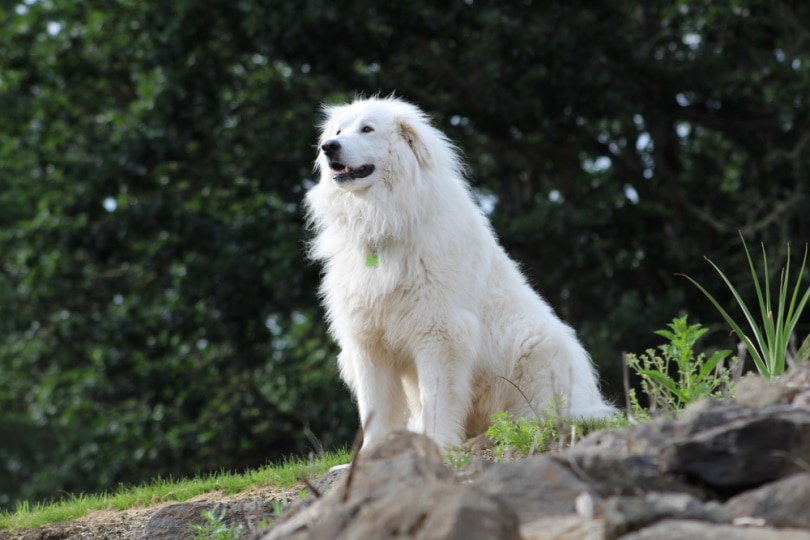
Health
The Great Pyrenees is generally a healthy breed with a lifespan of 10–12 years. As an owner, it is crucial to be aware of the dog’s predisposed health issues and provide them with the best care to live long and happy lives. Health issues they’re predisposed to, and reputable breeders should screen for, include growth disorders, patella luxation, eye disorders, neural degeneration, and gastric dilatation and volvulus (GDV).
It is vital to keep up with annual vet visits and vaccinations and to take preventative measures by administering tick, flea, and worm preventatives. Maintaining preventative care and a healthy diet will help your dog live happily for many years.
Diet
All dogs require a high-quality and well-balanced diet, and while many dog foods provide the protein, vitamins, and minerals that a dog needs, it is always best to consult your veterinarian. Your vet can also help guide you with the right portions and supplements. Generally, the Great Pyrenees will do well on a breed and life-stage appropriate food approved by the American Association of Feed Control Officials (AAFCO).
The Great Pyrenees tends to eat less than other large breeds, but feeding it appropriate portions based on its age and weight is essential to prevent obesity. It is recommended to feed it multiple small meals a day because it is prone to bloat.
Grooming
The gorgeous, double-white coat of a Pyrenees surprisingly doesn’t require much grooming. Their fur is naturally tangle-resistant, so they will only need to be brushed about once a week. However, you need to brush them daily during months of heavy shedding. A monthly bath will suffice, and their nails should be trimmed regularly since they are not very active. Their teeth should be brushed at least three times a week, along with dental chews to help prevent plaque build-up.

Suitable For:
The Great Pyrenees is suitable for patient owners looking for a large dog with minimal exercise needs. Their low energy levels and gentle nature make them great companions for just about any family, and they can easily adapt to urban areas. They will also thrive on a farm with livestock to protect and space to roam.
They are great companions for children, given that they know how to handle a large dog, and because of their low maintenance needs, they may be suitable for older couples or first-time owners. However, they require patience and consistency in training, so puppy classes will be incredibly beneficial if you are not an experienced owner.
- Gentle
- Affectionate
- Great watchdog
- Low grooming needs
- Low exercise needs
- Independent
- Sometimes difficult to train

Newfoundland Overview
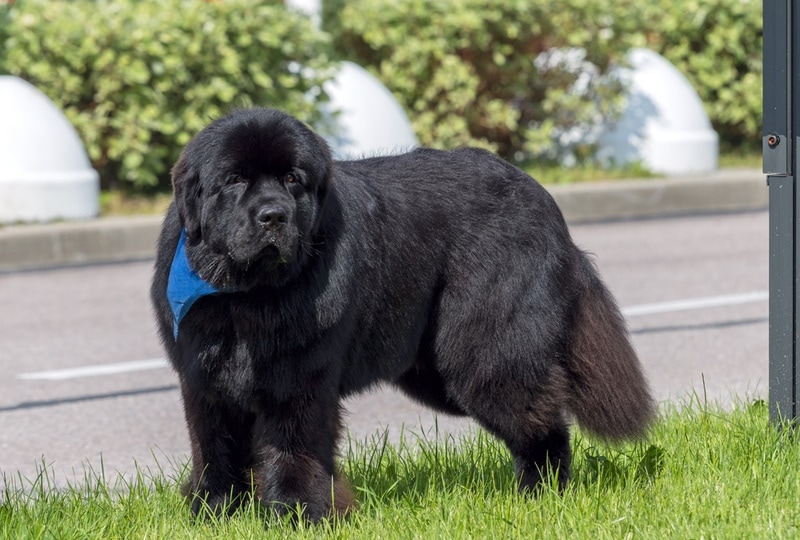
Better known by their owners as “Newfies,” Newfoundlands are surprisingly gentle and docile. They hold a reputation for being “nanny dogs” because of their patience and protectiveness toward children. This working dog feels at home on land and in water, and even though it is one of the friendliest breeds, there are challenges when it comes to owning a dog that possibly outweighs you.
Personality
Newfies are known to be one of the most docile and friendliest breeds. They’re lazy dogs that are friendly with their family and have unending patience toward kids. They are also a confident and intelligent breed, and although they can be docile and calm, they are also outgoing and fun-loving.
Training and Exercise
Surprisingly, the Newfoundland only requires about 30 minutes of moderate exercise a day. This large canine will be happy with daily walks with its owner and, even more so, a swim if there’s a large body of water nearby. They enjoy the outdoors, so a short hike will also be appreciated and keep your Newfie fit. If you enjoy canine sports, your Newfie will excel at cart pulling and will enjoy tracking, rally, herding, agility, and obedience courses.
Early socialization and training are essential for the Newfoundland so that it grows up to be a well-mannered and obedient dog. Fortunately, Newfies are eager to please their owners and are considered easy to train. While some may be stubborn, you can successfully train your Newfie with positive reinforcement and patience. If your Newfie is to be trained for water work, you should start training when they’re at least 4 months old.

Health
The Newfoundland is a generally healthy breed but does have a short lifespan, and like other dogs, it is predisposed to certain health issues that pet parents need to be aware of, such as Gastric dilatation-volvulus (GDV), elbow and hip dysplasia, bone cancer, dilated cardiomyopathy (DCM), and cystinuria. It is important to get your Newfie from a responsible breeder since they screen their dogs for those health issues. You should also keep up with annual vet check-ins, vaccinations, and preventatives for ticks, worms, and fleas.
Diet
The best way to determine the ideal diet for your Newfie is to talk to your veterinarian. Your vet can guide you on the best food, portions, and supplements. It is also helpful to talk to your vet about whether your Newfie’s diet should include grains, as there is a link between predisposed cardiomyopathy and a grain-free diet.
Generally, your Newfie is a large dog with a large appetite and requires a high-quality and well-balanced diet. The food you choose should be appropriate for its breed and life stage.
Grooming
A Newfoundland doesn’t require intense grooming. Brushing its coat once a week will keep its skin and fur healthy and prevent its coat from knotting. However, when shedding season comes around, they may need to be brushed daily to remove loose hair. You should brush their teeth at least three times a week and ensure their nails are trimmed regularly.
Newfoundlands are also known to drool occasionally, so ensure that you clean their mouth to avoid moisture buildup.

Suitable For:
Newfies make great companions to families with kids, and they are very protective, gentle, and friendly. However, kids must know how to interact with a large dog, and infants should be supervised around the dog. They will also make a great companion for a single person and first-time owners. Potential owners should consider the size of the Newfoundland and their available space. They don’t require a large outside space to run around and prefer to be inside, occupying space and lounging around. However, they enjoy a short hike or jump in the lake.
- Great with kids
- Great watchdog
- Gentle and docile
- Friendly
- Easy to train
- May take up a lot of space in a small home
- May drool occasionally

Which Breed Is Right for You?
When choosing the most suitable breed out of the two, you will need to look at training, exercise, and diet. Newfies are generally easier to train and are ideal for new owners. However, they require a little more exercise than the Pyrenees, but not by much. They are both large dogs that eat a large portion of food daily, but the Great Pyrenees generally eats less.
The Great Pyrenees and Newfoundland are suitable for families with kids, but the Newfie is the top choice and is tolerant of wild children.
Regarding their health, the Great Pyrenees has a slightly longer lifespan. Both dogs are predisposed to certain health conditions and require a healthy environment, regular veterinary care, and a well-balanced diet. Whether you bring home a Great Pyrenees of Newfoundland, you’ll have a loyal companion for several years.
Featured Image Credit: (T) Jumpstory | (B) Madeeva_11, Shutterstock
Tags
What do you think?
Related Articles

New Puppy Checklist: Gear You’ll Need for Your New Dog
Getting a new puppy is really exciting, but before you welcome them home, it’s important to prepare your space for them. Since puppies need a

How Big Do Mini Poodles Get? Vet Reviewed Average Weight & Growth Chart – Dogster
The information is current and up-to-date in accordance with the latest veterinarian research. Learn more » When you buy a Miniature Poodle, you might not

Can Police Dogs Smell Nicotine? Vet Verified Facts & Info – Dogster
The information is current and up-to-date in accordance with the latest veterinarian research. Learn more » While cigarette sales have been declining steadily for decades,

How Old Is 5 in Dog Years? Vet-Approved Guide to Each Size of Dog – Dogster
The information is current and up-to-date in accordance with the latest veterinarian research. Learn more » A common method for calculating a dog’s age is

